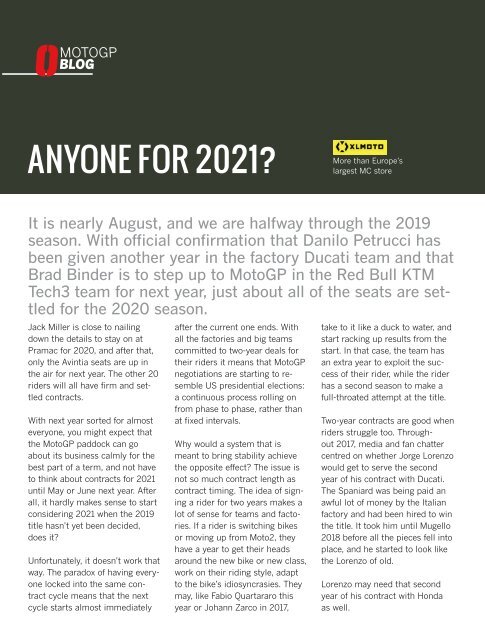You also want an ePaper? Increase the reach of your titles
YUMPU automatically turns print PDFs into web optimized ePapers that Google loves.
MOTOGP<br />
BLOG<br />
ANYONE FOR 2021?<br />
More than Europe’s<br />
largest MC store<br />
It is nearly August, and we are halfway through the 2019<br />
season. With official confirmation that Danilo Petrucci has<br />
been given another year in the factory Ducati team and that<br />
Brad Binder is to step up to MotoGP in the Red Bull KTM<br />
Tech3 team for next year, just about all of the seats are settled<br />
for the 2020 season.<br />
Jack Miller is close to nailing<br />
down the details to stay on at<br />
Pramac for 2020, and after that,<br />
only the Avintia seats are up in<br />
the air for next year. The other 20<br />
riders will all have firm and settled<br />
contracts.<br />
With next year sorted for almost<br />
everyone, you might expect that<br />
the MotoGP paddock can go<br />
about its business calmly for the<br />
best part of a term, and not have<br />
to think about contracts for 2021<br />
until May or June next year. After<br />
all, it hardly makes sense to start<br />
considering 2021 when the 2019<br />
title hasn’t yet been decided,<br />
does it?<br />
Unfortunately, it doesn’t work that<br />
way. The paradox of having everyone<br />
locked into the same contract<br />
cycle means that the next<br />
cycle starts almost immediately<br />
after the current one ends. With<br />
all the factories and big teams<br />
committed to two-year deals for<br />
their riders it means that MotoGP<br />
negotiations are starting to resemble<br />
US presidential elections:<br />
a continuous process rolling on<br />
from phase to phase, rather than<br />
at fixed intervals.<br />
Why would a system that is<br />
meant to bring stability achieve<br />
the opposite effect? The issue is<br />
not so much contract length as<br />
contract timing. The idea of signing<br />
a rider for two years makes a<br />
lot of sense for teams and factories.<br />
If a rider is switching bikes<br />
or moving up from Moto2, they<br />
have a year to get their heads<br />
around the new bike or new class,<br />
work on their riding style, adapt<br />
to the bike’s idiosyncrasies. They<br />
may, like Fabio Quartararo this<br />
year or Johann Zarco in 2017,<br />
take to it like a duck to water, and<br />
start racking up results from the<br />
start. In that case, the team has<br />
an extra year to exploit the success<br />
of their rider, while the rider<br />
has a second season to make a<br />
full-throated attempt at the title.<br />
Two-year contracts are good when<br />
riders struggle too. Throughout<br />
2017, media and fan chatter<br />
centred on whether Jorge Lorenzo<br />
would get to serve the second<br />
year of his contract with Ducati.<br />
The Spaniard was being paid an<br />
awful lot of money by the Italian<br />
factory and had been hired to win<br />
the title. It took him until Mugello<br />
2018 before all the pieces fell into<br />
place, and he started to look like<br />
the Lorenzo of old.<br />
Lorenzo may need that second<br />
year of his contract with Honda<br />
as well.

















